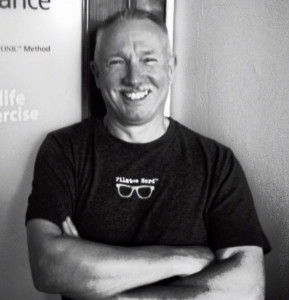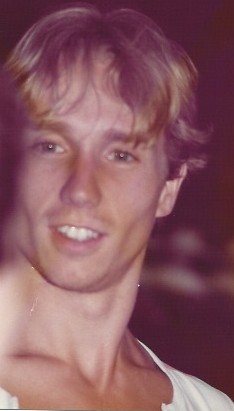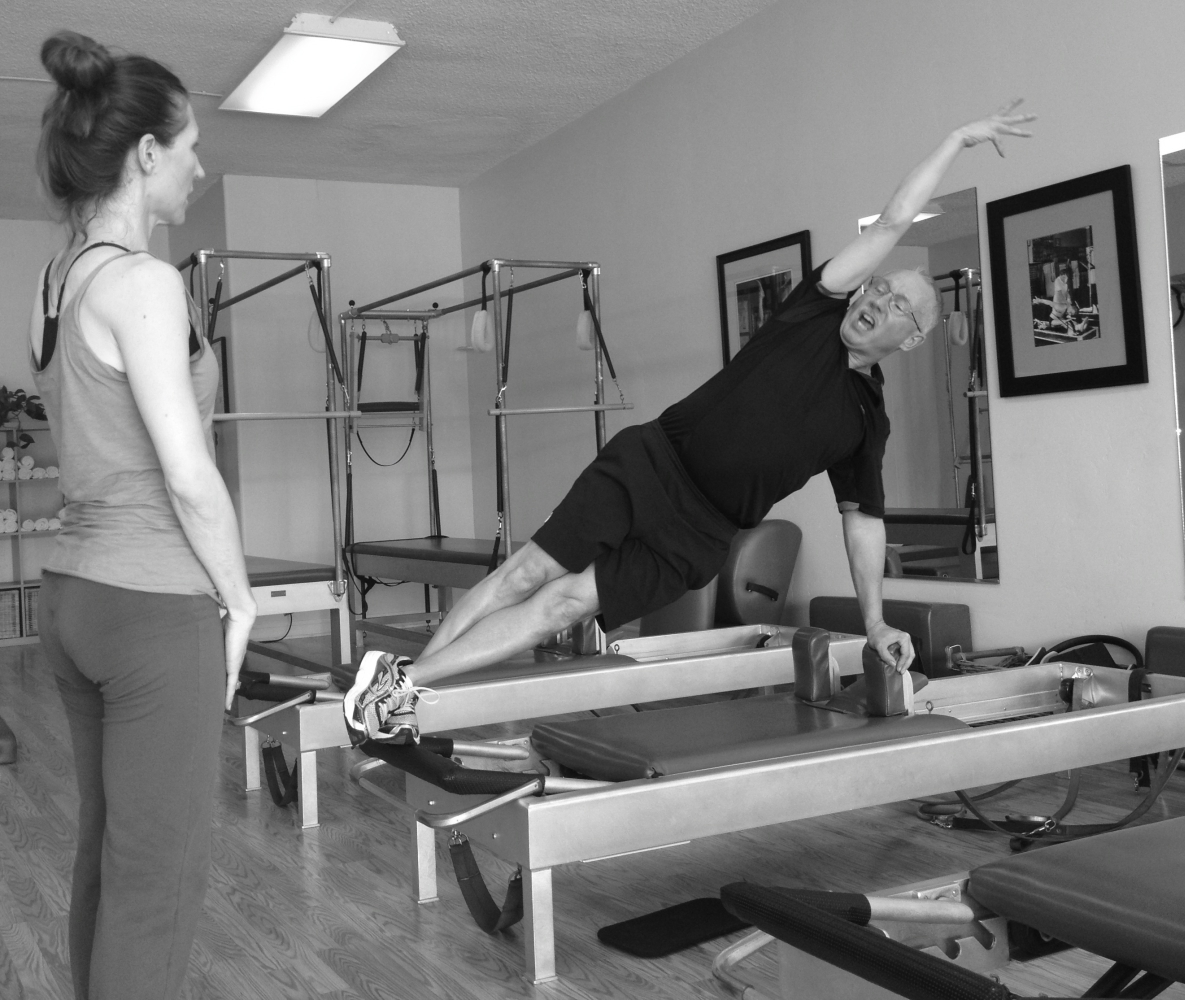I first met Bob at a Pilates Method Alliance conference in 2003, and I was impressed by his knowledge, generosity, humbleness, and effectiveness as a teacher. Here was the man who had the answers I wanted about Pilates, and was more than willing to share all that he knew! Since that initial meeting, I have met countless instructors who feel the same way about Bob: he is a true master of his craft, and a great teacher of teachers. I have made a concerted effort to study with Bob whenever I possibly can, and I never stop learning from him. He continues to be a tremendous inspiration for my practice and teaching. It was an honor and pleasure to have this opportunity to learn more about his life and experience. (Interview Sept. 19. 2013 in Encinitas, CA)
KWN: I know that you are from Belgium. Can you talk a bit about your background?

photo thanks to Julie Toren
BL: I have always been an artist, drawing and painting – making visual art. When I was a young teenager, I started to attend classes at the Center for the Arts in Brussels. At the Center, classes were offered in drawing, painting, photography, dance, and drama. I loved it there, and this community was very enriching for me. This experience opened up a whole new world to me, and this was how I started as an artist.
I was mainly interested in the visual arts, but my dancer friends noticed that I could jump quite high and asked me why I did not pursue dance. They encouraged me to audition, and I did. I was accepted to the Dance Academy in Rotterdam, and after four years of study I received a degree in Dance.

Right after graduating, Viola Farber, a Cunningham dancer and teacher, started a center in France. Hers was both a company and apprentice program. I was accepted to this program and was there for one year in France. After this time, Viola wanted to restart her company in New York. She invited me to join, and I accepted. I then went to New York, but unfortunately Viola decided to stay in London. Now that I had made it to New York, I decided to stay. I enrolled in the Cunningham Studio, and I loved it. During the next four years I performed with several pick-up companies, and I especially enjoyed a performance collaboration with Meredith Monk.
 When I left for New York, a friend of mine gave me a list of studios to visit in the city. On this list was a Feldenkrais practitioner, an Alexander Technique teacher, White Cloud Studio, and a Pilates studio. This is how I found my first Pilates teacher, Doug Ficochelli, who was teaching at Romana’s studio at that time. Her studio was on 56th Street, between Fifth and Sixth Avenue. This was February 1983. I remember that I enjoyed the people and the ambience there, but I had to wait to sign up for the initial 5 sessions because I did not have the money. At this time it was $125 for 5 sessions. When I saved up, I went back, and that was it!
When I left for New York, a friend of mine gave me a list of studios to visit in the city. On this list was a Feldenkrais practitioner, an Alexander Technique teacher, White Cloud Studio, and a Pilates studio. This is how I found my first Pilates teacher, Doug Ficochelli, who was teaching at Romana’s studio at that time. Her studio was on 56th Street, between Fifth and Sixth Avenue. This was February 1983. I remember that I enjoyed the people and the ambience there, but I had to wait to sign up for the initial 5 sessions because I did not have the money. At this time it was $125 for 5 sessions. When I saved up, I went back, and that was it!
KWN: When did you first meet Romana [Kryzanowska]?
BL: I met Romana during one of my lessons with Doug. I was doing the tree, and this older woman wearing white gloves came over and gave me a correction. The whole studio went completely quiet. I didn’t know who she was at the time, but Doug said, “Say thank you!” under his breath, so I said “Thank you,” and then she walked away. The white gloves I later discovered were inspired by Danilova, the Russian Ballet dancer/teacher who always wore white gloves too.
KWN: Did you start working with Romana at this time?
BL: My main teachers at this time were always Doug (Ficochelli), Cary Regan, and Phoebe Higgins. I was also at least three times a week at the studio doing my own practice. After three years of being there on this consistent basis, one day Romana approached me and said, “One of the teachers, Melanie, is sick. Bob, you teach today.” Initially, I objected, but Romana insisted. This was my introduction to teaching the Method. Then began my apprenticeship and teacher training all rolled up together! This is how it happened in those days.
 I taught for one year (1986) in the studio with Romana, and then went to Japan to pursue my studies of martial arts (Jodo) and dance theater (Noh).
I taught for one year (1986) in the studio with Romana, and then went to Japan to pursue my studies of martial arts (Jodo) and dance theater (Noh).
After one year in Japan, I returned to Europe. Sure enough, Cary Regan tracked me down. She called me and said, “We need you at the studio here in New York.” I agreed to it, but on the condition that I would have a full schedule this time. I moved back to New York City in 1988, a year after Wee Tai Hom had moved the studio to 56th between Third and Lexington Avenue.
KWN: I know that you were a student and teacher at the Martha Graham School. How did that come about?
BL: To continue my dance studies, I enrolled at the Martha Graham Center. After initially being introduced to Graham technique at the Dance Academy in Rotterdam, where it did not agree with me, now after all my Pilates practice I could do it and really enjoy it. In 1991, Diane Grey, the director of the school, started a teacher training program into which I was accepted. After completing this program, Diane invited me to teach. I felt very honored to teach the beginning levels for the next two years.
KWN: So how did you come to write the teacher training manual for Romana’s training program?
BL: When Sean Gallagher came onto the Pilates scene in 1991, he saw the potential for a training program. He asked one of his teachers, Carol Baker, to start writing a manual, which she accomplished basically overnight. She did an amazing job considering she had hardly any time to do it. The manual was definitely not complete, and Romana was always complaining about it.
This was the mid ‘90s. I was still in the process of completing my green card application, and one of the requirements was a written publication. I saw the window of opportunity, so I suggested to Romana that we work together to write a better manual. She said, “Yes, let’s do it! But not at the studio – let’s do it at my home.” For one year, sitting at her kitchen table regularly, we went over every exercise and rewrote the manual for the teacher training program.
KWN: Where do you see this field going? What kind of future do you see for people interested in the classical work?
BL: In the beginning, not many people knew about Pilates. Initially, it was the guys that Joe trained – the boxers, the martial artists, and a few wealthy patrons. In the 1940‘s, the dancers then discovered the Pilates method. It was very underground.
After the aerobics craze of the 80s, with all the pounding and injuries, there was a surge of interest in the “softer,” mind-body emphasizing, non-impact workouts of Yoga, Tai Chi, and Pilates. This surge is settling, and what was underground before is now mainstream. Today Pilates is all over the place, which is a good thing, but also a bad thing. Unfortunately, PIlates has gotten somewhat mixed reviews because people are getting injured or not achieving the expected results. Often, teachers are not receiving proper training.

I have also noticed that larger, more corporate Pilates studios are closing, where the smaller “mom and pop” style studios are thriving. I think that the work is more effectively passed down from teacher to student in these more “hands-on” and personal environments. It is in this more apprentice-style learning environment, this intimate atmosphere, that one absorbs the myriad nuances and details of the work. You must have this tactile, sensory experience to truly learn the Method.
 As far as approaches to the work, there will always be those who honor the tradition versus those who create their own interpretation. For those of us who know the tradition, I think it is our responsibility to keep it alive and pass it on to the next generation.
As far as approaches to the work, there will always be those who honor the tradition versus those who create their own interpretation. For those of us who know the tradition, I think it is our responsibility to keep it alive and pass it on to the next generation.
KWN: So what have you been doing since you left Power Pilates?
BL: I have been furthering my art career. I am taking a break to rejuvinate body, mind, and soul. I am gaining a new perspective on where I will go from here.
KWN: What do you like to do in your spare time, and for fun?
BL: I like to take art classes at Grand Central Academy in New York, and various workshops worldwide. I was recently in San Diego studying at Jeffrey Watts‘ studio and loved it. I enjoy traveling, and I’m especially fond of Florence, Italy. I enjoy frequenting museums and art galleries. On my travels, I often explore different spas, and I like to experience different approaches to massage and body work.
Artwork by Bob Liekens (A copy after Frans Hals)
KWN: Who and what inspires you?
BL: For Pilates, Romana inspires me. I feel responsible to her to pass on what she taught me. On the other hand, Yoga Philosophy and my Yoga teachers, especially John Friend, inspire me on a profound level. And as for my art career, it is Andrew Reese, my long term teacher in New York with whom I studied privately, who really got me back on track drawing and painting.
KWN: How has your study and practice of Yoga influenced your Pilates teaching and practice?
BL: My study of Yoga taught me a great deal about problem solving. Working with Romana taught me so much, but I had many questions as a young teacher pertaining to the Method and to the larger philosophical questions of body and soul.
I wanted to have a deeper understanding of how each person’s unique body-mind-spirit evolves through his or her movement practice. When I asked Romana about these matters, the answers she gave often did not satiate my curiosity. I was searching for more. Another Pilates teacher at Romana’s studio, Lea Chaback, who also studied Yoga, explained that perhaps pursuing Yoga would give me a deeper understanding of movement with a spiritual dimension that I was seeking. Studying Yoga has brought my Pilates teaching to an entirely new level, and I pursue my own Yoga practice to this day.
KWN: One of my dance teachers once told me that the teacher is only successful when her student is better than she is.
BL: There is an ancient Chinese saying: “Pity the teacher whose student does not surpass him.” That is definitely my philosophy with teaching.
KWN: Having practiced Pilates for so many years, how has your practice changed through these years? What wisdom can you share?
BL: Since I had a back injury, I must be very cautious of excessive aggravation of my low back. When you have an episode when you cannot move, it can be quite frightening. After so many years of excessive flexion and imprinting my low back, I needed a re-thinking of my practice. When I first started learning Yoga, my teachers strongly urged me to avoid and spinal flexion with loaded springs. At the same time, they encouraged extension. Different from my previous training, they encouraged balance in the spinal motions and this really strengthened my back. Now, when I do Pilates, I really enjoy doing the barrels and leg springs.
Also keep in mind that after fifty, you cannot do the same things that you did at twenty, thirty, or even forty. Equally, one loses his or her competitive edge and one begins to listen to the body more carefully. In this period, one has a different motivation for working out. A person tends to take a more gentle approach and give the body what it needs.
[box] “Pity the teacher whose student does not surpass him.” That is definitely my philosophy with teaching.[/box]
KWN: How has Pilates changed from when you first started teaching to now?
BL: When I started to teach, no one knew what Pilates was. Now, everyone at least recognizes the name, but they may not really know the Classical Method.
In the beginning, there was no advertisement. It was word of mouth, known only by dancers and insiders. The lawsuit made Pilates a household name. Is that good? This is open to conjecture. People need to be educated. They need to shop around. People need to see that the the Pilates method is not generic, and people should experience the work the way it was intended to be practiced.
At the Pilates Method Alliance conference several years back, Mary Pilates was there. Someone asked her a question along the lines of, “Wouldn’t Joe be proud to see how his method has grown and evolved?” She responded something like “No, because he would often not recognize what is now being sold as ‘Pilates’.” Half the room was cheering, half the room kept quiet.
(Intermediate Reformer Workout with Bob Liekens)
Karen Washburn Ness has been a PIlates Nerd and overall body Nerd for many years. This stems from her profound interest in how conditioning the mind and body together improves overall health and well-being. She started studying the method in 1995 to improve as a dancer, and thus the impetus to discover what Joseph Pilates created began. This journey continues and gets more interesting every day!
Her passion for movement, art, and teaching led her to pursue a career in Dance. After stints dancing and teaching in Venezuela and Brazil, and a Fulbright Fellowship to Indonesia, she graduated with her Masters in Dance from UCLA in 2001. However, during her last year of graduate school, her practice of Pilates and the desire to share this amazing work with ALL people led her to ultimately pursue her current profession: teaching the Method on a wider scale, not only to dancers in the university setting.
When she met Shari Berkowitz in 2002, and Bob Liekens shortly after, she became fully committed to studying and teaching the Classical Pilates Method from this lineage. She took sessions regularly with Shari for a decade, and also bridged into Power Pilates in 2004. When she became a Teacher Trainer in 2007, she had the opportunity to work more directly with Bob. She is a PMA-CPT. She is also certified in GYROTONIC (R) and GYROKINESIS (R) , and is a Preparatory Trainer for teachers in both. She owns Axis Classical Pilates and GYROTONIC (R) in Long Beach, California, where she teaches a diverse clientele who are a constant source of inspiration.
